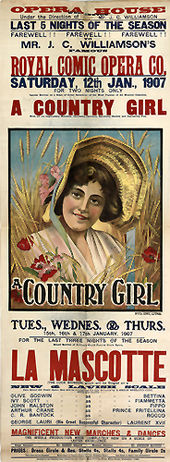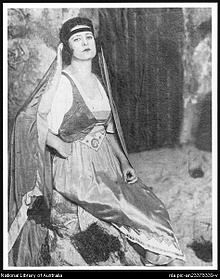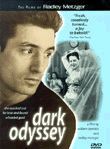Dear Donald,
And we have a new subscriber. See Administriva below for an introduction.
Enjoy.
| Introduction |
Ray Jerrems, Our Genealogist, Historian
LITTLE ALICE JERREMS
Has Ray finally gone bonkers, I hear you ask. Who on earth was the quaintly named “Little Alice Jerrems”?
Little Alice first came to my notice earlier this year when I was searching old newspapers, and I must admit that for a while I had no idea who she was, or why she was named “little”. Was she very small, or was she a child? Was she really a “Jerrems” or was this merely a stage name?
It soon became apparent that Alice was an actress, that she was a real “Jerrems” and at that time she was a child.
| Little Alice hits the big time |

The Perth Daily News of 4/9/1911 contained a review of the play “A Fool There Was”, including the following:
One of the heaviest parts in the drama, ‘The Child”, fell to Little Alice Jerrems, who was simple and unaffected throughout. It is wonderful that one so young could sustain such a role in so admirable a manner. In fact, it seems too heavy a part to ask a child of such tender years to undertake. But, whether playing with her father, or ‘Mr. Tom,’ or writing to her father, or playing with the Butler, there was nothing forced or artificial, only that frank simplicity, that unaffected unconsciousness which belong to children, and which only a child with very great intelligence and the highest histrionic gifts could portray. Little Alice Jerrems scored a triumph, which can only be the beginning of greater ones that the years have in store for her.
Little Alice Jerrems was the recipient: of a great box of chocolates, and she bowed her acknowledgments with all the old-fashioned grace of the early Victorian period.
The reviewer described the play as the story of a man lured by a siren from the calm, unruffled joy of a married life of unusual happiness and serenity, by mad infatuation for a cold-blooded she devil, who apes passionate love to allure men, and gluts her savage appetite by ruining them.
Little Alice had obviously made a great impression on the Daily News reviewer because a further review of 16/8/1912 enthused that:
Little Alice Jerrems, who plays the cripple child in ‘The Night Side of London’ and Wahneetah’s daughter in ‘Queen of the Redskins’, was last seen here with ‘The Woman in the Case’ Company, and is probably one of the cleverest children on the Australian stage.
Little Alice also received favourable reviews in 1915, including one for the play “East Lynne” (see earlier photo) based on Ellen Wood’s Victorian bestselling novel. In it, Lady Isabel Carlyle, a beautiful and refined young woman, leaves her hard-working but neglectful lawyer-husband and her infant children to elope with an aristocratic suitor. After he deserts her, and she bears their illegitimate child, Lady Isabel disguises herself and takes the position of governess in the household of her former husband and his new wife.
Alice took part in plays in Perth, Adelaide, Melbourne, Hobart and Auckland (New Zealand), gaining a lot of experience in the process. Then there is a gap in my records, probably explained by the advent of the First World War.
Although it was not essential for a company to have a child playing a child’s role (an adult could play the role, dressed as a child) it was no doubt attractive for a company of the size of J C Williamsons to have an actual child. The publicity would also have helped the company.
From Alice’s viewpoint it would have been exciting to travel by train or ship and see other cities, presenting a stark contrast with the routine of going to school in run-down Richmond. However her mother would have had to arrange alternative schooling for her.
Although Richmond left a lot to be desired, at least it was only a short tram trip from Melbourne’s CBD where the company was based, and Alice had many relatives living there.
| Little Alice continues the good work |
Although Alice was no longer “little” she continued working in the theatre, gaining a brief mention in the Adelaide Advertiser of 20/11/1920:
A SPLENDID ENTERTAINMENT
It was really a phenomenal audience that gathered at the Garden Theatre in the Exhibition. Grounds to-night, when the long-anticipated opening night of J C. Williamson Ltd’s “So-and-So” opened. Thousands of people filled every seat in the auditorium, swarmed all along the terraces, and up the steps in eager expectation of something very special in the way of an alfresco entertainment.
Right from the start there was not the slightest doubt about the brilliant success of this talented company. After the ushers had done their best to cope with the apparently never-ending stream of patrons and “God Save the King” had heralded the arrival of His Excellency the Governor the curtain rose on the full length of the company artistically garbed in black and-gold pierrot and pierette costumes. The opening chorus “the So-and-So’s” was brisk and tuneful.
Gracy Lavern, who is well and favourably known to Adelaide audiences, gave as her first item ‘The Tickle-Toe’ from ”Going Up,’ with chorus by the four ”Madcaps” (Alice Jerrems, Del Barnes, Dorothy Ryder, and Hilda Kirby).
Guests included the Lord Mayor and Premier.
| Alice disappears from thespian sight |
Perhaps surprisingly, the only later reference to Little Alice was early in 1921 when she was still in the cast of “So and So”. A possible explanation is that she stayed in the chorus at J C Williamsons and was not singled out in reviews. Perhaps J C Williamsons had shifted from playing melodramas (where Alice specialised as a child) to musicals and operettas where Alice had a singing voice suitable for the chorus but not the lead role where JCW had specialist singers. This shift could have resulted from the First World War Or was there another reason?
Fortunately I found two Death Notices, one in 1948 for John McKnight, from which it was apparent that he was Alice’s husband, the other in 1953 for Madeline Victoria Jerrems, Alice’s mother.
Alice had married John Stanislaus McKnight (b1896 in the mid-southern Sydney suburb of Marrickville) in the 1920s. They settled down at 130 Homer Street in the adjacent suburb of Earlwood , Sydney, living with John’s mother Sarah Phyllis McKnight. John was an electrician and Alice may have retired from the theatre to help with her husband’s business. He died at the comparatively early age of 52.
I also worked out that Alice’s mother was the wife of a William George Jerrems. William (not to be confused with our editor’s great grandfather of the same name) was one of the eight Melbourne-based children of Robert Cane/Cain Jerrems, my great grandfather’s brother. William and Madeline lived in Richmond, Melbourne, where William was at various times a carter, cleaner and labourer (showing no obvious thespian leanings). William died in the mid 1930s, and Madeline moved to Sydney after she retired in the early 1940s.
She lived with Alice and John until her death in 1953. In addition to having family support (assisted by John’s mother, who lived at the same address until at least 1943), Madeline would have found Earlwood to be a far more salubrious suburb than Richmond.
| Keeping it in the family |

I was still none the wiser as to why or how Alice had started acting, until I saw the following article about her mother in the Perth “Western Australian” of 3/7/41.
SEASONED TROUPER – 33 Years as Wardrobe Mistress.
THIRTY THREE years with the J. C. Williamson Co. is a record of which any good trouper would be proud and Mrs. M. Jerrems, wardrobe mistress of the visiting Gilbert and Sullivan Opera Company, or “Jerry” as she is called, has this distinction to her credit. “With all its ups and downs, I love the life,” she said yesterday, “and wouldn’t think of leaving it.” She also added that her experience had been extensive in that she had been interested in the wardrobe side of the theatre in all its phases-from grand opera to melodrama. “As yet I haven’t been mixed up with a circus,” she said, “but who knows?”
Although she plays an “unseen” part in the show, all would be confusion without the guiding hand of Mrs. Jerrems. In addition to the continual pressing and repairs before each performance, she is responsible for the clothes when they are bought-choosing the materials and following -through in the initial stages. All the costumes worn by the company in the operas now being put on were made in the firm’s ward robe department in Melbourne, she stated. Then there is also the business of keeping costumes and “props” from moths and insect pests and that, when one has viewed case upon case at the theatre, seems no small job in itself. When one sees the wig worn by Ivan Menzies in “Trial by Jury,” for instance, it is not realised by audience members that it cost over £100 and that it is stored in a special tin trunk with a wired buttercloth inside cover. Keeping an eye on this wig, incidentally, is the unenviable job of the wardrobe master.
Asked how she came to be connected with the theatre, Mrs. Jerrems said that she had been “led astray” by her daughter (then aged three and a half years), who was playing a child’s part in “The Dairy maids,” one of Jenny Brennan’s productions. On one occasion there was an upset in the wardrobe department and she had been asked to “help out.” Shortly afterwards she found herself installed in the department for good. Most women find it quite enough to look after their own clothes, but Mrs. Jerrems is responsible for dressing over 30 girls. Her responsibilities leave her unperturbed, however, and she sits happily in the midst of her clothes, with “Pirates” on her left and “lolanthes” on her right-ready for future performances-and a roomful of chattering girls bobbing in and out between scenes.
The precocious Little Alice
The above article shows that Alice was three and a half when she began her acting career!
The article also provides an explanation as to how she started acting, and also how she continued. With her mother working for the famous J C Williamsons her mother could look after her, and in later years chaperone her, when the company was touring.
| J C Williamson |

This company was formed by the American J C Williamson in Australia in 1881 and soon made its mark with imported artists like Sarah Bernhardt and (later) Dame Nellie Melba. It also toured in England and the United States and at its peak was recognised as being the largest theatrical firm in the world.
Alice was up against strong opposition because the legendary soprano Gladys Moncrieff (affectionately known as “our Glad”) began the lead singing role in 1917 in “Maid of the Mountains”, in which she had 2800 performances. Gladys also had an early start, first singing in a public performance at the age of six.
Earlier the company had also become famous for staging “Ben Hur” at Her Majesty’s Theatre in Melbourne (see photo of theatre), with a real chariot and horses galloping on the stage on rollers.
The theatre companies produced eye-catching posters for their shows (see poster for “A Country Girl”).
Theatre companies were well known for putting on extravaganzas. According to my father, in the late 1920s or early 1930s the children of the famous Australian swimmer Richmond “Dick” Cavill (1884-1938) put on diving displays at the Sydney Capitol Theatre by diving out of the ceiling into a water tank on the stage, a height of at least 60 feet (18 metres). My grandfather raced against Dick in the early 1900s and my father knew the children.
When Alice was part of the company stage entertainment had a very high profile, dominating the entertainment industry before the advent of “silent films” and “talkies”.
The curtain comes down for Alice and John
John died at the relatively early age of 52, his Death Notice referring to a number of relatives but no children. Alice, who was (at a guess) born in about 1903, lived until at least 1963 in the family home at Earlwood.
| Gladys Moncrieff |

| Was Alice our most notable actress? |

It would be accurate to say that Alice was the most notable child actress bearing the Jerrems name, but Jeanne Jerrems was definitely the most notable actress, starring in a later era in a film (“Dark Odyssey”) and numerous plays in the United States (see Jerrems Journals of November 2005, February 2006 and January 2007).
| Administrivia |
Donald Jerrems, Editor, Publisher
Ray and Greg’s Email Exchange
We welcome a new subscriber. I have forwarded Gregory’s email to Ray so they can connect.

Pictured: Bay Street in Brighton-le-Sands today
=====================================
Hello Donald,
Thanks for your response. I must say how delighted I was to find your webpage.
My connection to the Jerrems ancestry is thru my “Aunt” Jess Jerrems (nee Hetherington)* and her husband Charles**. Jess was technically my 1st cousin once removed – her father (Thomas Albert Hetherington) being my maternal grandfather’s brother – but she was older than me, and I always knew her as Aunt Jess, and her husband as Uncle Charles. I have very fond memories of visits to them at their house in Brighton-le-Sands when I was a kid, living in Sydney.
As I recall they had a daughter Gwen Sheekie (nee Jerrems), who was some years older than
me ( I was born 1943), but I have totally lost track of her, and the rest of that branch of my
extended family over the years. My recollection of Gwen is that she had been a missionary in New Guinea when I was a kid, and I met her from time to time when she was visiting her parents.
I’d very much like to hear from anyone with connections to or recollections of Jess and Charles, and family.
I’m prettty sure I’ll have some photos of Jess and Charles buried in our old family snapshots – I’ll see if I can dig them out.
Best regards
Greg Acland
Cornel University, New York
=====================================
Hi Greg
Donald passed your email on to me.
My grandfather (Ernest Alfred Jerrems) was one of Charles’s brothers.
You are the first person I have heard from on the Hetherington side.
I have not heard of Gwen Sheekie (nee Jerrems) before. One of Charles and Jessies’ two daughters (she was a nurse) married a minister and later they spent quite a long time on missionary work in New Guinea. The other daughter died several years ago. Both daughters have a considerable number of descendants.
I would be interested in hearing more about the Hetheringtons.
Regards
Ray

